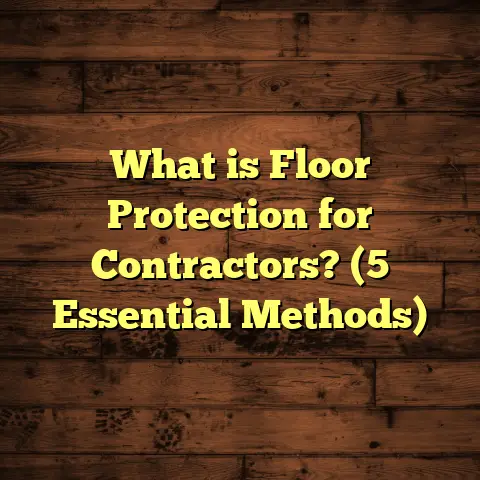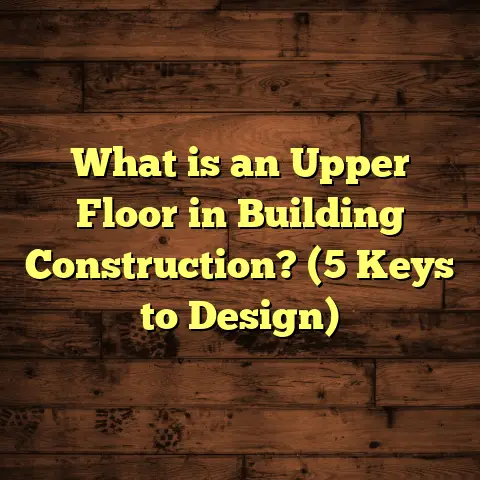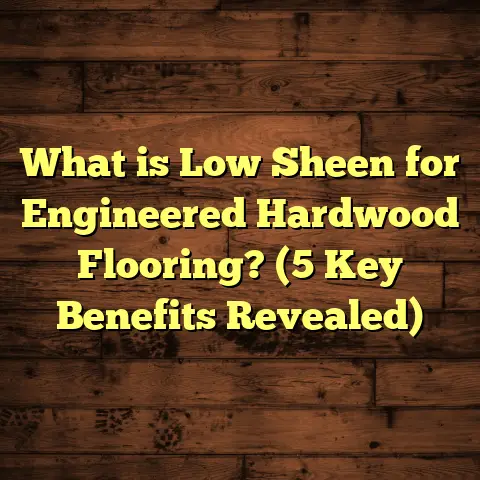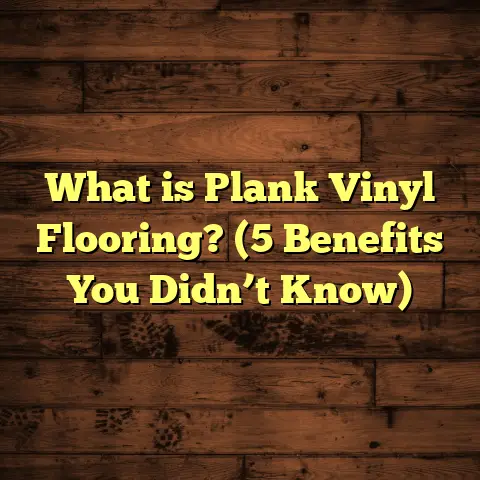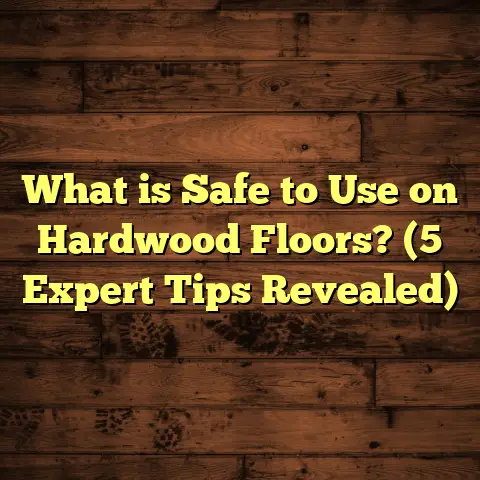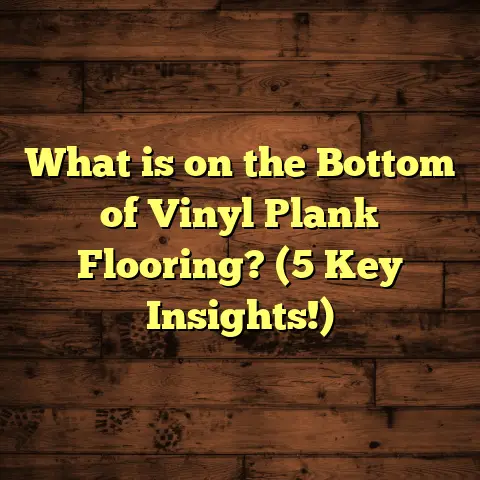What is Bamboo Wood Flooring? (5 Benefits You Didn’t Know)
What if you could have a flooring material that’s not only beautiful and durable but also eco-friendly and surprisingly affordable? Imagine walking barefoot on your floor, feeling the smooth yet sturdy surface beneath your feet, knowing that your choice is also helping the planet. Sounds like a win-win, right? Well, that’s exactly what bamboo wood flooring offers.
What Is Bamboo Wood Flooring?
Let me start by breaking down what bamboo wood flooring really is. Unlike traditional hardwood floors that come from trees, bamboo flooring is made from the fast-growing bamboo grass. Yes, grass! Bamboo can grow up to 3 feet in 24 hours under the right conditions, which makes it one of the most renewable materials out there.
Bamboo flooring is created by cutting the bamboo stalks into strips and then compressing them under heat and pressure with adhesives to form planks. These planks are then finished with a protective coating. The whole process results in a material that looks very similar to hardwood but has some unique characteristics of its own.
There are mainly three types of bamboo flooring:
- Horizontal bamboo, where the bamboo strips are laid flat so you can see the natural nodes or “knuckles” of the bamboo.
- Vertical bamboo, where strips are stood upright giving a more uniform, linear look.
- Strand-woven bamboo, which is made by crushing and weaving strands of bamboo fibers together, creating a super-dense and incredibly strong plank.
I first came across strand-woven bamboo about a decade ago while working on a residential renovation project in Portland, Oregon. The client wanted something eco-friendly but durable enough for their active family with kids and pets. I was amazed at how well this type of bamboo held up compared to some hardwoods.
Bamboo vs Hardwood: What’s the Difference?
If you’re wondering how bamboo compares to traditional hardwood flooring materials like oak, maple, or walnut, here’s what I’ve learned over years of experience:
- Growth Rate: Hardwood trees take decades to mature—some species up to 50 or 60 years before harvesting. Bamboo takes only 3-5 years depending on species and climate.
- Hardness: Strand-woven bamboo often scores higher on the Janka hardness scale than many hardwoods. For instance, strand-woven can reach 6,000 pounds of force resistance compared to red oak’s 1,290 pounds.
- Environmental Impact: Bamboo harvesting promotes sustainability if managed correctly; hardwood logging often contributes to deforestation.
- Cost: Bamboo flooring usually costs less upfront and requires less intensive maintenance.
- Appearance: Bamboo offers unique grain patterns and colors that differ from traditional hardwoods and can complement modern or rustic interiors.
Based on these factors, I often recommend bamboo floors for clients looking for a balance between style, durability, and environmental responsibility.
5 Benefits of Bamboo Wood Flooring You Didn’t Know About
1. Fast Growth Means Sustainability
Bamboo grows much faster than any hardwood tree. While an oak tree might take 20-30 years to mature, bamboo can be harvested every 3-5 years depending on the species and climate. This rapid renewability means that bamboo flooring is far less likely to contribute to deforestation.
I remember reading a study from the International Network for Bamboo and Rattan (INBAR) that reported bamboo forests can sequester up to 12 tons of carbon per hectare annually. That’s more than many traditional forests! So, by choosing bamboo, you’re actually helping reduce carbon footprints.
More than that, the harvest process for bamboo doesn’t kill the plant—it regrows from its root system without needing to be replanted. This contrasts sharply with hardwood logging where trees are cut down entirely.
2. Durability That Surprises Many
People often assume bamboo is as soft as regular grass, but that’s not true at all. Strand-woven bamboo, in particular, scores between 6-7 on the Janka hardness scale, which measures how resistant wood is to denting and wear. For comparison, red oak—the most common hardwood flooring—scores around 6.
During one job in Dallas, I installed strand-woven bamboo in a commercial office where the foot traffic was heavy daily. Even after two years, there were minimal scratches or dents, proving its resilience.
The strand-woven manufacturing process makes this flooring extremely dense—often twice as dense as traditional hardwoods—so it withstands impacts better than many woods. This quality makes it excellent for homes with pets or kids who tend to be tough on floors.
3. Cost-Effective Flooring Choice
One thing I love about bamboo flooring is its price point. On average, you can expect to pay anywhere between $3 to $8 per square foot for the material alone. Installation costs vary depending on location and complexity but typically range from $2 to $5 per square foot.
For example, my recent project in Austin involved installing 1,000 square feet of strand-woven bamboo flooring. The total cost, including labor and materials, was about $7,500—significantly less than what the same space would have cost using traditional hardwood like maple or walnut.
To get accurate estimates like this quickly, I’ve been using FloorTally for my projects. It helps me calculate local material prices and labor rates instantly and factors in waste percentages so I don’t end up ordering too much or too little. It’s saved me hours compared to calling multiple suppliers or contractors for quotes.
4. Aesthetic Versatility
Bamboo flooring comes in various colors and finishes—from natural light honey tones to deep espresso shades. Plus, it can be polished to a high gloss or left matte depending on your style preference.
What I find interesting is how well bamboo blends with different design styles. In one client’s modern farmhouse renovation in Seattle, we paired vertical bamboo planks with reclaimed wood accents and neutral walls. The result was warm yet contemporary.
The grain patterns themselves are unique since they show long horizontal lines and nodes characteristic of bamboo stalks. Some homeowners prefer horizontal grain for rustic charm; others like vertical or strand-woven for more modern looks.
5. Hypoallergenic and Easy to Maintain
If anyone in your household suffers from allergies or asthma, bamboo flooring might be a great fit. Because it doesn’t trap dust or allergens like carpet does, it contributes to better indoor air quality.
I often recommend bamboo flooring for families with kids and pets because it’s easy to clean with just regular sweeping and occasional damp mopping. Plus, it resists moisture better than many hardwoods when properly sealed—making spills less of a nightmare.
In my experience installing bamboo in several households with allergy sufferers, clients have commented on noticeable improvements in air comfort inside their homes shortly after installation.
Installation Methods: What You Need To Know
If you decide on bamboo flooring for your home or office space, understanding installation options can save you headaches later.
Nail-down Installation
This is commonly used over wooden subfloors where planks are nailed directly down. It provides a very sturdy floor but requires a suitable underlayment and sometimes professional skills.
Glue-down Installation
Glue-down works well over concrete slabs or when adding floors over radiant heating systems. Adhesive is spread on the subfloor before placing the planks down.
Floating Floors
Many engineered bamboo floors can be installed as floating floors where planks click together over an underlayment without being fixed directly to the subfloor. This method is popular for DIYers due to relative ease and speed.
How I Use FloorTally To Simplify My Projects
Estimating costs accurately has always been one of the trickiest parts of my job—especially when dealing with multiple materials and labor rates varying by city or neighborhood.
FloorTally became a game-changer for me when I started using it about three years ago. Here’s why:
- It pulls local pricing data automatically based on your zip code.
- Lets me select from dozens of materials including various types of bamboo.
- Calculates waste factor automatically (usually around 5-10%) so I order enough but not too much.
- Estimates labor costs based on local averages.
- Helps me visualize total project costs clearly so I can give clients realistic budgets upfront.
One project where FloorTally saved me big was a 1,500 square foot condo remodel in Denver last year. Instead of guessing prices or calling multiple suppliers individually—which could take days—I got a detailed cost breakdown within an hour that factored in local labor rates plus premium strand-woven bamboo material options.
This allowed me to advise my client confidently on budget adjustments early on rather than running into surprises mid-project.
Personal Stories: Bamboo Flooring in Action
Over my years installing floors across different states, I’ve gathered plenty of stories about how bamboo transforms spaces — both practically and visually.
The Family With Energetic Kids
In my Portland project with strand-woven bamboo floors, the family had three young boys who loved running around and sometimes spilled juice or tracked mud inside after soccer games. The parents told me months later they were thrilled because cleaning was easy and the floor showed minimal wear despite all the chaos.
The Allergy Sufferer Who Found Relief
A client in Minneapolis had severe dust allergies but didn’t want cold tile floors in her living room. Installing vertical strand-woven bamboo gave her warm aesthetics plus reduced dust accumulation dramatically compared with carpet she had before.
Office Space That Lasted Years
The Dallas commercial office project was interesting because many employees initially doubted whether bamboo could handle heavy daily use from wheeled chairs and foot traffic. But after two years without refinishing or repairs needed, they were convinced it was a smart investment.
Environmental Impact: Beyond Just Fast Growth
Choosing eco-friendly materials involves more than just renewability—it’s about how production affects ecosystems and communities too.
Sustainably harvested bamboo supports rural economies particularly in countries like China and Vietnam where it’s grown extensively under regulated programs.
Moreover:
- Bamboo plantations help prevent soil erosion due to dense root systems.
- Harvesting practices typically maintain biodiversity within plantations.
- Production uses less water compared with hardwood tree farming.
- Carbon sequestration rates are impressive: some studies say up to 30% higher than pine forests over time.
If you want numbers: According to a recent Life Cycle Assessment (LCA) by researchers at Yale University:
- Bamboo flooring production emits approximately 65% less CO2 equivalent than traditional hardwood flooring.
- It requires half the energy during processing.
- End-of-life disposal is easier since bamboo biodegrades faster than treated hardwoods.
Maintenance Tips To Keep Your Bamboo Floors Looking New
Keeping your floors beautiful over time is just as important as choosing them:
Daily Care:
- Sweep or vacuum regularly using soft-bristle attachments.
- Avoid wet mopping; instead use a damp mop with pH-neutral wood cleaner.
- Wipe spills immediately to prevent staining or water damage.
Long-Term Care:
- Use furniture pads under legs to avoid scratches.
- Consider refinishing every 7–10 years depending on wear patterns.
- Avoid harsh chemicals or abrasive cleaners which can damage finish layers.
Comparing Bamboo With Other Popular Flooring Options
Here’s a quick snapshot I put together based on my experience working with clients who debated between choices:
| Flooring Type | Cost per Sq Ft | Durability (Janka Hardness) | Eco-Friendliness | Maintenance | Appearance Variety |
|---|---|---|---|---|---|
| Strand-Woven Bamboo | $4 – $8 | 6 – 7 | High | Low | Medium |
| Red Oak Hardwood | $5 – $12 | ~6 | Medium | Medium | High |
| Laminate | $1 – $4 | ~4 | Low | Low | High |
| Vinyl Plank | $2 – $5 | ~3 | Low | Low | High |
| Carpet | $2 – $8 | N/A | Low | High | Medium |
This table shows why many people lean toward bamboo when balancing cost, durability, sustainability, and ease of care.
Common Myths About Bamboo Flooring Debunked
You might hear some things about bamboo that make you hesitate:
Myth 1: Bamboo is weak like grass.
Fact: Strand-woven bamboo is denser than most hardwoods and very durable.
Myth 2: Bamboo scratches easily.
Fact: It resists dents better than red oak; scratches can happen but are usually superficial.
Myth 3: Bamboo yellows or fades quickly in sunlight.
Fact: Like all wood products, it may darken slightly over time but proper finishes reduce this effect.
Myth 4: Bamboo isn’t waterproof.
Fact: While not fully waterproof like vinyl tile, quality strand-woven floors sealed well resist moisture better than many hardwoods.
I always encourage clients curious about these concerns to ask for samples or visit homes with installed bamboo floors before deciding.
How To Choose The Right Bamboo Flooring For Your Home
Here’s how I usually guide clients through choices:
- Consider traffic levels: Strand-woven for high traffic; horizontal or vertical for lighter use.
- Decide on plank width: Wider planks create spacious feel; narrower offer classic look.
- Choose finish: Matte for rustic; gloss for polished modern spaces.
- Check origin: Look for certifications like FSC (Forest Stewardship Council) ensuring sustainable harvest.
- Set budget: Factor material + installation + maintenance costs upfront using tools like FloorTally.
Wrapping Up My Thoughts On Bamboo Flooring
After installing hundreds of thousands of square feet of various flooring types over my career, I’ve found bamboo stands out as an exceptional choice for many reasons beyond what you first see at the store display.
It balances:
- Durability
- Price
- Eco-friendliness
- Style versatility
- Easy upkeep
If you’re looking for flooring that fits an active lifestyle without compromising values or aesthetics—bamboo wood flooring deserves serious thought.
Have you ever stepped onto a bamboo floor before? What surprised you about it? If you’re considering new floors soon, feel free to ask me anything about installation or cost—I’m happy to share tips from my experience plus how I use FloorTally for smarter budgeting every time I take on a new project.
